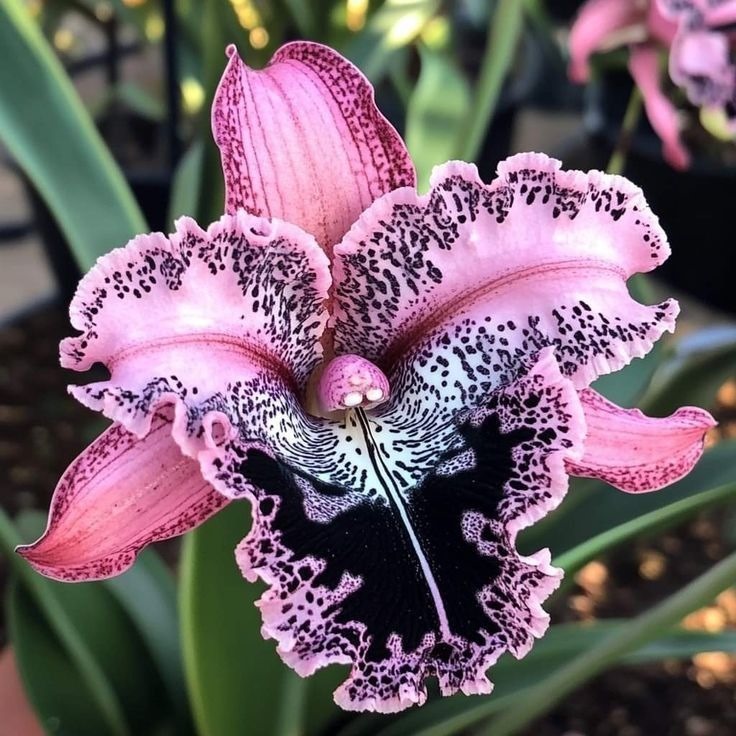The Cattleya Orchid is a truly captivating and exotic species that has earned a special place in the hearts of orchid enthusiasts worldwide. With its vibrant colors ranging from purple, pink, yellow, and white to more unusual hues like orange and red, it’s no surprise that Cattleyas are often referred to as the “queen of orchids.” Known for their ruffled petals and intricate structures, these orchids are the epitome of elegance and beauty in the orchid family.
Key Features of the Cattleya Orchid
1. Stunning Flowers:
Cattleya orchids are often regarded for their large, showy flowers that can span several inches in diameter. The blooms are made even more striking by their ruffled edges, giving them a delicate and ethereal appearance. These flowers can last anywhere from a few weeks to a couple of months, depending on the variety and environmental conditions.
Cattleyas also have a rich fragrance, making them a favorite for floral arrangements and indoor decor. The aroma ranges from sweet to spicy and is typically stronger in the morning and evening, making them a fragrant delight for anyone near them.
2. Vibrant Colors and Varieties:
These orchids come in a wide range of colors and varieties. Some of the more common colors include purple, pink, yellow, white, and orange. Many Cattleyas have contrasting lip markings or speckled petals, which add depth and dimension to the blooms. The variety of shapes and colors ensures there is a Cattleya to match every home or garden space.
Growing Conditions for Cattleya Orchids
Cattleya orchids are native to the tropical and subtropical regions of the Americas, where they thrive in warm, humid climates. Replicating these conditions indoors can be key to growing healthy Cattleyas with beautiful blooms.
1. Temperature:
Ideal Range: Cattleyas thrive in warm temperatures, ideally between 18-30°C (64-86°F). These orchids enjoy consistent warmth, but sudden temperature fluctuations can stress them and impact blooming.
Night Temperature: It is beneficial for Cattleyas to experience a slight drop in temperature at night (around 18°C or 64°F). This temperature variation can help stimulate blooming.
2. Light:
Cattleya orchids require bright, indirect sunlight. Direct sunlight can scorch their delicate petals, so it’s best to place them near a window that receives filtered light or in an area with dappled sunlight.
Signs of Insufficient Light: If your orchid isn’t blooming or the flowers are small and pale, it may not be receiving enough light.
Signs of Too Much Light: If the leaves turn yellow or appear scorched, it’s an indication that the orchid is exposed to too much direct sunlight.
3. Humidity:
These orchids naturally grow in high humidity environments. Cattleyas prefer humidity levels between 50-80%. To maintain this indoors, consider using a humidity tray, placing your orchid near other plants, or using a room humidifier.
If the air is too dry, especially during the winter months, misting the plant occasionally can help, but be sure to avoid letting water sit on the leaves for too long to prevent fungal issues.
4. Air Circulation:
Cattleyas require good air circulation to help prevent diseases like mold and rot. Ensure that the growing space has proper ventilation. A ceiling fan or open window can help maintain good airflow, especially in humid environments.
Watering and Fertilizing Cattleya Orchids
Proper watering and fertilizing are crucial for the health of Cattleya orchids. Here’s a breakdown of how to do it right:
1. Watering:
Drying-Out Period: Cattleya orchids are particularly sensitive to overwatering, so it’s essential to allow the growing medium to dry out between waterings. The roots of Cattleyas prefer to stay somewhat dry, and excessive moisture can lead to root rot.
Watering Frequency: Water your orchid every 7-10 days, depending on the temperature and humidity levels in your home. Water thoroughly, ensuring the water runs out of the drainage holes at the bottom of the pot.
Signs of Overwatering: Yellowing leaves and mushy, blackened roots are often the first signs of root rot caused by overwatering.
2. Fertilizing:
Cattleyas benefit from regular fertilization, but it’s important to use a balanced orchid fertilizer. During the growing season (spring and summer), fertilize every 2 weeks with a dilute solution of fertilizer (about one-quarter strength).
In the dormant period (fall and winter), reduce fertilization to once a month or stop altogether. Excess fertilizer during dormancy can harm the plant.
Repotting Cattleya Orchids
Repotting is necessary for Cattleya orchids every 1-2 years to refresh the growing medium and to allow the plant to grow freely. Repotting is best done in early spring, just after the plant has finished blooming.
Steps for Repotting:
Remove the Orchid from its Pot: Gently remove the orchid from its pot and inspect the roots. Trim off any dead or damaged roots with sterilized scissors or pruning shears.
Prepare a New Pot: Choose a slightly larger pot with drainage holes to allow excess water to escape. Use an orchid mix made of bark, perlite, or coconut husk for the potting medium. Cattleya orchids require well-draining medium to thrive.
Repot the Orchid: Place the orchid in the new pot and fill it with fresh potting mix. Gently firm the medium around the roots. The base of the orchid should be level with the edge of the pot.
Water After Repotting: Water lightly after repotting to help the orchid settle into its new home.
Common Issues with Cattleya Orchids
Despite their beauty, Cattleya orchids can face certain challenges:
1. Root Rot:
As mentioned earlier, overwatering can lead to root rot, a common issue for orchids. Always allow the medium to dry out before watering again.
2. Pests:
Cattleyas are fairly resistant to pests, but they can occasionally be affected by mealybugs, aphids, or scale insects. These pests can be treated with insecticidal soap or by wiping the affected areas with a cotton swab dipped in rubbing alcohol.
3. Flower Problems:
If your Cattleya isn’t blooming, it may be due to insufficient light or an incorrect temperature range. Ensure that the orchid is getting enough bright, indirect light and that the temperature is in the right range for blooming.
Displaying Cattleya Orchids
Cattleya orchids make stunning ornamental plants for any home or garden. Here are a few ideas for displaying them:
1. Decorative Pot:
Choose a decorative pot that complements the vibrant colors of the Cattleya’s blooms. You can use ceramic, clay, or even wooden pots, depending on the style you prefer.
2. Hanging Baskets:
Cattleya orchids with pendulous growth habits look beautiful in hanging baskets, allowing their stunning flowers to cascade elegantly.
3. Floral Arrangements:
Because Cattleyas have such large and fragrant flowers, they are often used in floral arrangements, adding a touch of exotic elegance to bouquets and centerpieces.
Conclusion
The Cattleya Orchid is a majestic and exotic plant that can bring a touch of elegance and beauty to any space. While it does require some care and attention, particularly with temperature, light, and watering conditions, its large, fragrant blooms are well worth the effort. By providing the right environment—warm temperatures, bright indirect light, good humidity, and regular care—your Cattleya orchid will reward you with stunning flowers season after season. Whether you are a seasoned orchid grower or just starting, the Cattleya is a truly special orchid species that can thrive in the right conditions, adding a regal touch to your home or garden.
More Articles You Might Like
-
Texas Toast Sloppy Joes: The Crunchy, Cheesy Upgrade You Didn’t Know You Needed
There’s something timeless about sloppy joes. For generations, this saucy, savory, and slightly sweet ground beef sandwich has been a go-to comfort food in American kitchens. It’s quick, filling, and family-friendly—perfect for busy weeknights. But what if we told you there’s a way to take this classic dish up a notch? Enter the Texas Toast…
-
Classic Pig Pickin’ Cake
When it comes to Southern desserts, few sweets shine as brightly as the Classic Pig Pickin’ Cake. This nostalgic cake, sometimes called a “Mandarin Orange Cake,” has roots deep in Southern tradition. It gets its playful name from its frequent appearance at pig pickin’s—Southern-style barbecue gatherings where communities come together to enjoy slow-cooked pork, sides,…
-
Lemon Garlic Butter Chicken with Creamy Parmesan Pasta
There’s something irresistible about the combination of tender, golden-browned chicken paired with a creamy pasta coated in Parmesan cheese. Add the brightness of lemon, the depth of garlic, and the richness of butter, and you have a recipe that feels indulgent yet approachable enough for a weeknight dinner. Lemon Garlic Butter Chicken with Creamy Parmesan…



